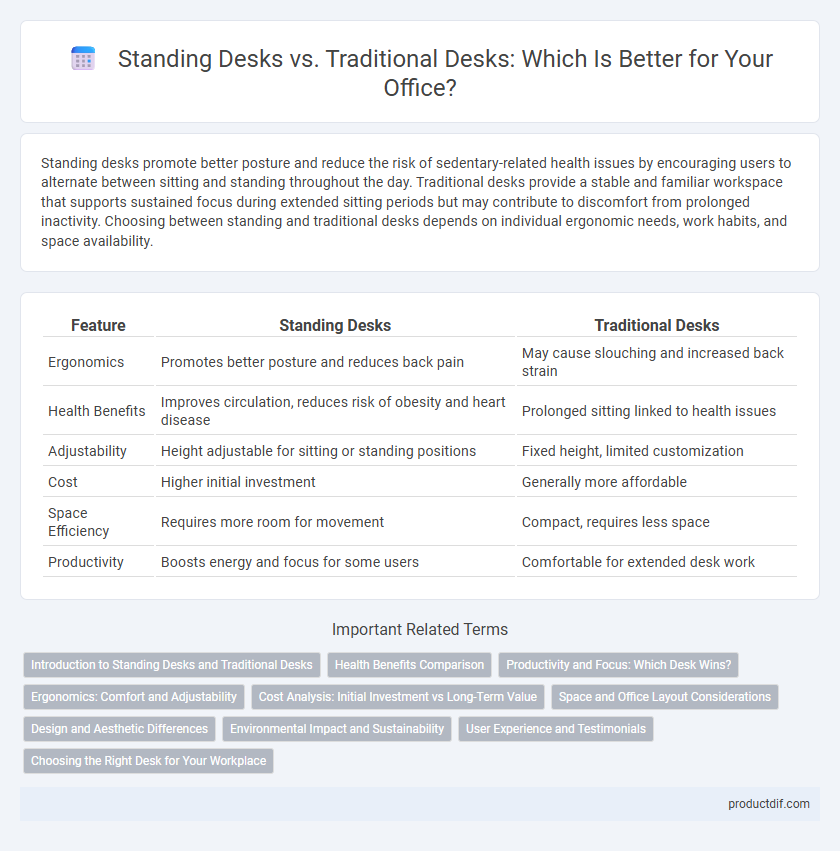Standing desks promote better posture and reduce the risk of sedentary-related health issues by encouraging users to alternate between sitting and standing throughout the day. Traditional desks provide a stable and familiar workspace that supports sustained focus during extended sitting periods but may contribute to discomfort from prolonged inactivity. Choosing between standing and traditional desks depends on individual ergonomic needs, work habits, and space availability.
Table of Comparison
| Feature | Standing Desks | Traditional Desks |
|---|---|---|
| Ergonomics | Promotes better posture and reduces back pain | May cause slouching and increased back strain |
| Health Benefits | Improves circulation, reduces risk of obesity and heart disease | Prolonged sitting linked to health issues |
| Adjustability | Height adjustable for sitting or standing positions | Fixed height, limited customization |
| Cost | Higher initial investment | Generally more affordable |
| Space Efficiency | Requires more room for movement | Compact, requires less space |
| Productivity | Boosts energy and focus for some users | Comfortable for extended desk work |
Introduction to Standing Desks and Traditional Desks
Standing desks offer ergonomic benefits by allowing users to alternate between sitting and standing, promoting better posture and reducing the risk of sedentary-related health issues. Traditional desks provide a stable, familiar workspace typically designed for sitting, favored for tasks that require prolonged focus and comfort. Choosing between standing and traditional desks depends on individual work habits, ergonomic needs, and office space layout.
Health Benefits Comparison
Standing desks reduce the risk of cardiovascular disease and improve posture by encouraging movement and less prolonged sitting compared to traditional desks. They help decrease back pain and promote better circulation, which enhances overall workplace ergonomics and productivity. Studies show users of standing desks report lower levels of fatigue and musculoskeletal discomfort versus those who remain seated for extended periods.
Productivity and Focus: Which Desk Wins?
Standing desks enhance productivity by promoting active posture and reducing fatigue, which helps maintain focus during long work sessions. Traditional desks offer ergonomic comfort but may contribute to sedentary behavior, leading to decreased concentration over time. Studies indicate that integrating standing desks in the workplace can boost cognitive function and sustained attention, making them a superior choice for productivity and focus.
Ergonomics: Comfort and Adjustability
Standing desks offer superior ergonomics by promoting better posture and reducing the risk of musculoskeletal disorders compared to traditional desks. Adjustable height settings allow users to alternate between sitting and standing positions, enhancing comfort and reducing fatigue throughout the workday. Traditional desks often lack this flexibility, leading to prolonged static postures that can cause discomfort and decreased productivity.
Cost Analysis: Initial Investment vs Long-Term Value
Standing desks typically require a higher initial investment, ranging from $300 to $1,200, compared to traditional desks that average between $100 and $500. Over time, standing desks can offer long-term value by improving employee health and productivity, potentially reducing healthcare costs and absenteeism. While traditional desks have lower upfront costs, they may lack ergonomic benefits that impact overall workplace efficiency and employee well-being.
Space and Office Layout Considerations
Standing desks often require more vertical space and flexible office layouts to accommodate adjustable heights and movement, making them ideal for dynamic work environments. Traditional desks typically have a fixed footprint and height, allowing for more compact arrangements and easier integration into smaller or shared office spaces. Optimizing office layout with standing desks can improve workflow by encouraging movement, while traditional desks maximize space efficiency in confined areas.
Design and Aesthetic Differences
Standing desks feature sleek, modern designs with adjustable heights and minimalist frames that complement contemporary office aesthetics, promoting ergonomic benefits. Traditional desks offer classic styles crafted from wood or composite materials, often with more bulk and storage options, fitting well in conventional or executive office settings. The choice between standing and traditional desks impacts workspace visual appeal and user comfort, aligning with personal or corporate design preferences.
Environmental Impact and Sustainability
Standing desks often utilize sustainable materials such as bamboo and recycled steel, reducing the carbon footprint compared to traditional desks made from non-renewable resources like particleboard and plastic laminates. The modular design of many standing desks extends their lifespan and promotes easier recycling, minimizing landfill waste. In contrast, traditional desks frequently contribute to environmental degradation due to shorter durability and less eco-friendly materials.
User Experience and Testimonials
Standing desks offer improved ergonomics and increased energy levels, reducing back pain and boosting productivity according to multiple user testimonials. Traditional desks remain favored for their stability and ample surface space, providing comfort for extended seated tasks. User feedback highlights standing desks as ideal for dynamic work settings, while traditional desks suit preference for prolonged seated focus.
Choosing the Right Desk for Your Workplace
Standing desks promote improved posture and increased energy, reducing risks of sedentary-related health issues, while traditional desks offer familiarity and generally lower costs. Assess workspace layout, employee needs, and task types to determine whether adjustable-height desks or fixed traditional desks better support productivity and comfort. Incorporating ergonomic features like adjustable monitor stands and anti-fatigue mats can enhance any desk setup in your office environment.
Standing desks vs Traditional desks Infographic

 productdif.com
productdif.com